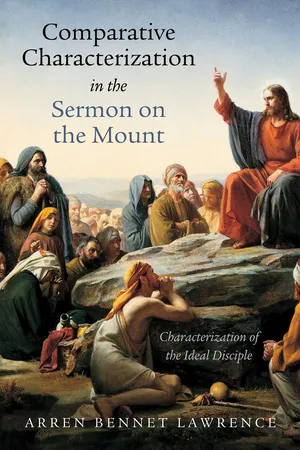
Comparative Characterization in the Sermon on the Mount
Characterization of the Ideal Disciple
- 284 pages
- English
- ePUB (mobile friendly)
- Available on iOS & Android
Comparative Characterization in the Sermon on the Mount
Characterization of the Ideal Disciple
About This Book
The Sermon on the Mount contains many comparisons. In this book, the functions of these comparisons are studied by the methodology called comparative characterization. Characterization is the way a character is characterized in a narrative. Comparative characterization is the characterization of a character using comparisons. In comparative characterization, another character is used as a foil to bring out a characteristic trait of a concerned character. Jesus characterized the ideal disciple in the Sermon on the Mount with many descriptions and imperatives. To characterize the ideal disciple Jesus used many comparisons and highlighted the characteristic features that embody the ideal disciple.The many comparisons used in the Sermon on the Mount are identified in this study through comparative characterization. In addition, the teleological purpose of the comparisons, which is to play as foil to the characterization of the ideal disciple, is identified and highlighted. Thus, this study identifies Jesus' characterization of the ideal disciple and his complex portrayal of the ideal disciple with the many uses of comparisons in the descriptions and imperatives of Jesus in the Sermon on the Mount.
Frequently asked questions
Information
Comparative Characterization as a Methodology to Interpret the Comparisons in the Sermon on the Mount
| 5:17 | Do not think that I came to abolish the Law or the Prophets; I did not come to abolish but to fulfill. |
| 5:20 | For I say to you, that unless your righteousness surpasses that of the scribes and Pharisees, you shall not enter the kingdom of heaven |
| 5:21 | You have heard that the ancients were told, v.22 But I say to you . . . |
| 5:27 | You have heard that the ancients were told, v.28 But I say to you . . . |
| 5:31 | And it was said, v.32 but I say to you . . . |
| 5:33 | Again, you have heard that the ancients were told, v.34 But I say to you . . . |
| 5:38 | You have heard that it was said, v.39 But I say to you . . . |
| 5:43 | You have heard that it was said, v.44 But I say to you . . . |
| 5:47 | “And if you greet your brothers only, what do you do more than others? Do not even the Gentiles do the same? |
| 6:2 | When therefore you give alms, do not sound a trumpet before you, as the hypocrites |
| 6:5 | And when you pray, you are not to be as the hypocrites |
| 6:7 | And when you are praying, do not use meaningless repetition, as the Gentiles |
| 6:8 | Therefore do not be like them |
| 6:16 | And whenever you fast, do not put on a gloomy face as the hypocrites do |
| 6:19 | Do not lay up for yourselves treasures upon earth |
| 6:32 | For all these things the Gentiles eagerly seek |
| 7:15 | Beware of the false prophets |
1.1 The Role of Comparisons in the Sermon on the Mount
Table of contents
- Title Page
- Preface
- Acknowledgments
- Abbreviations
- Chapter 1: Comparative Characterization as a Methodology to Interpret the Comparisons in the Sermon on the Mount
- Chapter 2: Sermon on the Mount in Literature
- Chapter 3: Narrative Criticism in New Testament
- Chapter 4: Comparative Characterization as a Methodology to Interpret Matthew 5–7
- Chapter 5: Characterization of the Ideal Disciple in Matthew 5:1–16
- Chapter 6: Comparative Characterization in Matthew 5:17–48
- Chapter 7: Comparative Characterization in Matthew 6:1—7:29
- Chapter 8: Comparative Characterization of the Ideal Disciple in the Sermon on the Mount and Its Implications
- Bibliography